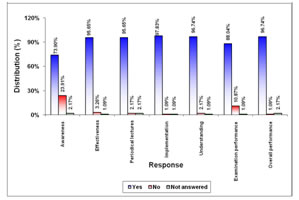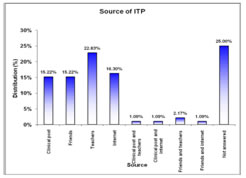Official Journals By StatPerson Publication
|
Table of Content - Volume 11 Issue2 - August 2019
Students perception towards integrated teaching program
Bhavane A*, Bellad A**, Nikam K**, Kalyanshetti S**
*Associate Professor, **Assistant Professor, Department of Physiology, BIMS, Belagavi, Karnataka, INDIA. Email: draroonabhavane@yahoo.co.in
Abstract Background: Medical education is a very vital part of health care system. The teaching is more of compartmentalization, where each department teaches the same topic at different time during the course. Hence comprehension of a topic by the student becomes difficult. In order to avoid such problems the concept of Integrated Teaching is required to be incorporated into the curriculum. This will prevent unnecessary repetition, disjointed approach to teaching, and confusion in students mind due to difference of opinion leading to improper grasping of the subject. Aims and Objectives: To know the students perception towards integrated teaching program, to sensitize them to the same and to know the importance of basic sciences in clinical diseases. Methodology: This study was conducted on 92 final MBBS students, who consented to participate in the study. A cross sectional study of horizontal and vertical integrated teaching programme was conducted. The session was for 3hours with speakers from preclinical, paraclinical and clinical departments. Each speaker spoke for 20 -30 minutes. At the end of the session the students had to answer a feedback questionnaire regarding their perception of integrated teaching. Results: 22.83 % of students got to know about ITP from their teachers. 95.65% students said ITP was very effective TL tool, 95.65% wanted periodically such lectures to be conducted, 97.83% to be implemented in the curriculum. Horizontal and vertical integration of pulmonary TB made it very easy to understand (96.74%) and thus the overall performance will improve in university examinations (96.74%). Conclusion: Our study concluded that integrated teaching program was better than traditional teaching. It helps in understanding the importance of basic sciences and correlating basic sciences knowledge with clinical disease. Key Word: horizontal integrated teaching, vertical integrated teaching
INTRODUCTION The meaning of the term curriculum is the teaching content in one subject area. An integrated curriculum (IC), in short , explains the fusion of knowledge from different disciplines; the approach to learning and teaching from a variety of world-views, strategies, and resources; and the tapping of real-life situations for problem solving and critical thinking in the classroom 1. As there is advances in scientific knowledge, and inventions in the educational field or scientific knowledge it is the need of time to change in medical school curricula. So many inventions and trends which have been undertaken globally include education for capacity building, community orientation or participation in medical education, self learning, problem based learning, integration and early patient contact. An integrated medical curriculum means non compartmentalized approach to basic sciences whereby lectures on closely related subjects like embryology, histology, anatomy, physiology and pathology, are alternated over the course of first two years2, organized around organ systems such as cardiovascular or nervous with a major component of problem based learning. GPEP report3, ACMI-TRI project report4 and recommendations of General Medical Council, UK5 propose the need for greater integration of subjects in the medical curriculum. Medical colleges in India have been following a traditional curriculum, characterized by "discipline wise model" with a high degree of compartmentalization into subjects of basic sciences, paraclinical and clinical branches. Several areas of redundancy, repetition and overlapping along with the observation of a gap between the qualitative and quantitative advancement in medical education and achievements in the field of health care prompted the Medical Council of India to adopt a need based curriculum for undergraduate medical education in India. "Regulations on Graduate Medical Education, 1997" recommend a teaching approach characterized by maximal efforts to encourage integrated teaching between traditional subject areas using a problem based learning approach and de-emphasize compartmentalization of disciplines so as to achieve both horizontal and vertical integration in different phases6 So we have studied medical Students Perception towards integrated RESULT Table 1: Reaction towards implementation of ITP
Graph 1: reaction towards implementation of ITP From Table 1 and Graph 1 it is clear that 73.9% students found it will increase the Awareness; 95.65 found it will be Effective ; 95.65 % of students needs Periodical lectures ; 97.83 students want Implementation of this ; 96.74 found it will be useful for Understanding ; 88.04 found it will increase Examination Performance ; 96.74 found it will increase Overall Performance From Table 1 and Graph 1 it is clear that 73.9% students found it will increase the Awareness; 95.65 found it will be Effective ; 95.65 % of students needs Periodical lectures ; 97.83 students want Implementation of this ; 96.74 found it will be useful for Understanding ; 88.04 found it will increase Examination Performance ; 96.74 found it will increase Overall Performance Table 2: Source of ITP
As per the Source of ITP the most common source was Teachers i.e. 22.83%, followed by Clinical postings in 15.22%, from Friends in 15.22%, from Internet in 16.3%, Friends and teachers In 2.17%, Clinical post and teachers, Clinical post and internet, Friends and internet was 1.09% and 25.00% peoples Not answered it. Figure 2: Source of ITP Table 3: Rating of overall ITP in pulmonary tuberculosis topic
As per Rating of overall ITP in pulmonary tuberculosis topic in Understanding 43.48% found Very good; 30.43 found Excellent, 15.22% found Good, 8.69% found Satisfactory 2.17% found Not applicable. In Appreciation -38.04% found Very good, 26.09% found Excellent, 23.91% found Good, 9.78% found Satisfactory, 2.17% found Not applicable. In Application - 34.78% found Very good, 32.61% found Excellent, 18.48% found Good, 10.87% found Satisfactory and 3.26% found Not applicable.
DISCUSSION Medical education is changing rapidly, with more than half of the American schools being engaged in curricular reforms. Many of these modifications focus on implementing horizontal or vertical curricular integration. Horizontal integration blends either the related basic science disciplines in order to enhance the student’s understanding of the body systems, or the related clinical science disciplines through interdisciplinary clerkships.7 According to the students integrated teaching is important as it helps to clear concept of the topic leading to better understanding with less fragmentation, reduces repetition as well as it is less time consuming analogous to other studies8,9,10. But at the same time few students have mentioned that it is time consuming11,12 The present system of education follows a building block principle where each subject has its own frame, restricted to one part of the course. The disadvantages of such a system are unnecessary repetition, disjointed approach to teaching creating confusion in student's mind leading to failure of grasping the subject of medicine as a whole. Curriculum integration has therefore evolved as an important strategy in medical education13. Various integrated medical curricula have been adopted by many medical schools all over the globe to ensure holistic approach rather than a fragmented one in medical education to encourage meaningful learning14. In India, some medical colleges have introduced integrated teaching program with student centered case based learning to enhance clinical learning15,16. Modules have been introduced in training of students in medical schools following traditional curriculum in the first year and also in clinical clerkship. Such programs have been found to enhance student knowledge and integration of that knowledge together with improved attitude towards medical education. In our study we have seen that that 73.9% students found it will increase the Awareness ; 95.65 found it will be Effective ; 95.65 % of students needs Periodical lectures ; 97.83 students want Implementation of this ; 96.74 found it will be useful for Understanding ; 88.04 found it will increase Examination Performance ; 96.74 found it will increase Overall Performance As per the Source of ITP the most common source was Teachers i.e. 22.83%, followed by Clinical postings in 15.22%, from Friends in 15.22%, from Internet in 16.3%, Friends and teachers In 2.17%, Clinical post and teachers, Clinical post and internet, Friends and internet was 1.09% and 25.00% peoples Not answered it. As per Rating of overall ITP in pulmonary tuberculosis topic in Understanding 43.48% found Very good; 30.43 found Excellent, 15.22% found Good, 8.69% found Satisfactory 2.17% found Not applicable. In Appreciation -38.04% found Very good, 26.09% found Excellent, 23.91% found Good, 9.78% found Satisfactory, 2.17% found Not applicable. In Application - 34.78% found Very good, 32.61% found Excellent, 18.48% found Good, 10.87% found Satisfactory and 3.26% found Not applicable. These findings are similar to Sarmishtha Ghosh et al17 they found Sixty percent students rated the program good to excellent with reference to appreciation, understanding and application of basic science knowledge in health and disease. Seventy eight percent felt that this program will help them perform better in later days of clinical training. However sixty percent students felt that ILP will not help them perform better at the first professional examination. Seventy two per cent of faculty agreed that this program improved understanding and application of basic science knowledge of students. Ninety percent of faculty felt that this program will help them perform better in later days of clinical training
CONCLUSION Our study concluded that integrated teaching program was better than traditional teaching. It helps in understanding the importance of basic sciences and correlating basic sciences knowledge with clinical disease
REFERENCES
|
|
||||||||||||||||||||||||||||||||||||||||||||||||||||||||||||||||||||||||||||||||||||||||||||||||||||||||||||||||||||||||||||||||||||||||||||||||||||||
 Home
Home


